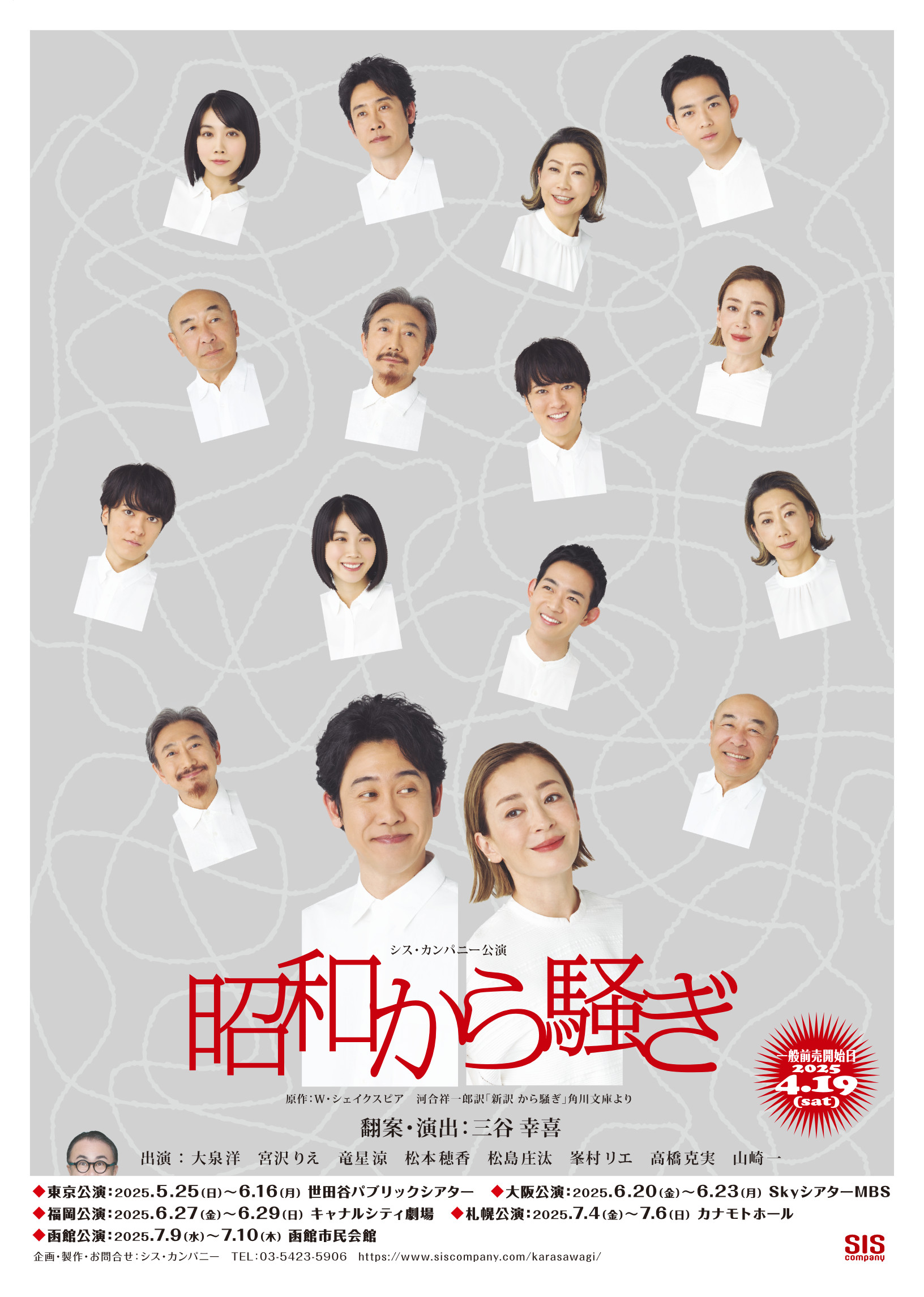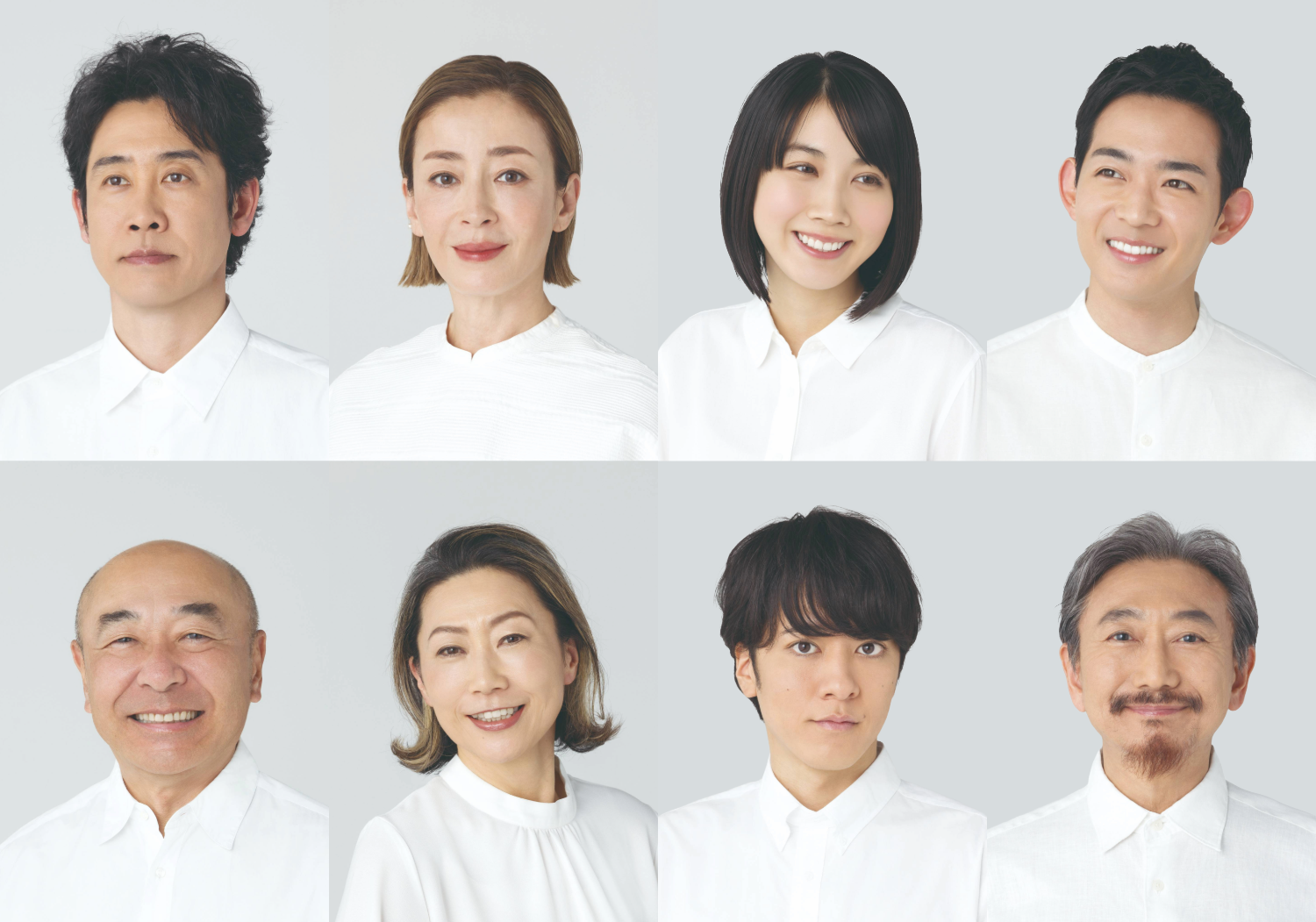Shakespeare Through the Lens of Ozu. Interview with Koki Mitani
Koki Mitani talks about Shakespeare and Koki Mitani’s Much Ado About Nothing
is one of Japan’s most celebrated screenwriters, playwrights, and film directors, renowned for his sharp wit, ensemble storytelling, and deep affection for both Japanese and Western comedic traditions. A graduate of Nihon University College of Art, he began his career in theater by founding the Tokyo Sunshine Boys (named after the play ‘The Sunshine Boys’ by Neil Simon) in 1983, where he made a name for himself as a screenwriter and stage director with fast-paced, character-driven comedies like ‘12 Gentle Japanese’ and ‘University of Laughs’, a good number of which have been later made into movies. Expanding into film in the late 1990s, Mitani wrote and directed numerous critically acclaimed works such as ‘Welcome Back, Mr. McDonald’, ‘Our House‘, ‘The Uchoten Hotel‘, ‘The Magic Hour‘, ‘A Ghost of a Chance’, and ‘The Kiyosu Conference’, blending tightly constructed plots with sharp humor and a humanistic tone.
His latest comedy film ‘All About Suomi‘ premiered in 2024, starring Masami Nagasawa in the leading female role. Mitani also gained fame in television for creating the beloved detective series ‘Furuhata Ninzaburo’, which paid homage to ‘Detective Columbo’. Influenced by directors like Frank Capra, Billy Wilder and Woody Allen, he favors dialogue-driven narratives, minimal visual effects, and performances grounded in realism, even when his stories veer into the absurd. His work is marked by an optimistic worldview and frequent use of ensemble casts, often featuring recurring actors.
In addition to winning numerous awards, including Japan Academy Prizes and Blue Ribbon Awards, Mitani is also known for his engaging public persona and contributions to Japanese popular culture. Despite drawing heavily from Western influences, his works remain deeply rooted in Japanese sensibilities, making him a unique and influential figure in both theater and cinema. ‘Koki Mitani’s Much Ado About Nothing’ is his first take on Shakespeare.
When I think about it, the very act of translating Shakespeare into Japanese already turns it into something quite different from the original. That’s why I’ve always questioned how meaningful it really is to try to faithfully stick to Shakespeare’s original words. Since we’re already departing from the source just by switching languages, I’ve long felt that taking creative liberties might actually bring us closer to the spirit of what Shakespeare wanted to express.
That’s always been my perspective. And if I were to direct a Shakespeare play—especially since I’ve mostly worked in comedy—I would naturally be drawn to one of his comedies. But for it to have any meaning for a modern Japanese audience, it has to be genuinely funny. Thus from the beginning, I felt it was essential to adapt the work in a way that would resonate with contemporary viewers in Japan.
That led me to the idea of setting the play in a familiar, Japanese environment. I thought it would be ideal to reimagine it as a modern Japanese comedy. When I considered which play might best fit that approach, ‘Much Ado About Nothing’ stood out. It was the most adaptable, largely because it doesn’t involve fantasy elements like magic, switching places, or fairies. Instead, it’s a fairly realistic story about the emotional and psychological games between men and women, which made it much easier to reframe in a Japanese context.
Then the question became: how do you express that in a Japanese way? The original play is set in Sicily. In Japan, we have the filmmaker Yasujiro Ozu, whose work often uses Italian or Neapolitan folk music as background music. In particular, his film ‘Floating Weeds‘—which is about a traveling theater troupe arriving in a village—has an atmosphere that feels surprisingly similar to a Sicilian port town.
That’s when I started seeing parallels—between Ozu and Shakespeare, and especially between Ozu and ‘Much Ado About Nothing’. As I read the play, I imagined what if Ozu had directed a film version of it? Through that lens, I started to see something very Japanese in the story: people acting out of goodwill, but unintentionally complicating matters; a certain emotional entanglement and sense of community—those very human dynamics felt deeply familiar.
And of course, while ‘Floating Weeds’ wasn’t set there, many of Ozu’s films take place in Kamakura. So I decided to use Kamakura as the setting for my adaptation. It felt very Ozu-like: a well-off household in Kita-Kamakura, with a university professor as the father and two daughters living at home. That setup is quintessentially Ozu. In the original, soldiers arrive; in my version, I replaced them with traveling performers.
From that point, the process became about how to adapt each element to fit this setting. And I really think it all came together quite naturally.
There’s something about Shakespeare and Kawashima, though the latter has a slightly cooler, more refined vibe. As for Shakespeare, to be honest, I don’t think there are many real similarities between him and Yasujiro Ozu. It’s more of a feeling, an impression that lingers.
When you think of Ozu, one of his signature techniques comes to mind: the way characters speak directly to the camera, head-on. It reminds me, in a way, of Shakespeare’s monologues—those moments when a character turns to the audience and speaks from the heart. Perhaps it’s that quiet intimacy, that directness, that made me feel a faint echo of Shakespeare in Ozu’s work.
I’d say most people in Japan are only familiar with Shakespeare’s four major tragedies and ‘Romeo and Juliet’. Those are the plays that get performed the most. There are certainly theatre companies that specialize in Shakespeare, but ‘Much Ado About Nothing’ seems to have been performed less frequently compared to the previously mentioned dramatic pieces. People may recognize the titles, but I don’t think many have a deep or detailed understanding of the works.
As for ‘Much Ado About Nothing’, I remember being genuinely surprised when I saw Kenneth Branagh’s film adaptation. What struck me was that in Japan, when Shakespeare is performed, it often comes across as somewhat inaccessible—which I think is one of the reasons his work hasn’t really taken root here. There’s a tendency for actors to approach Shakespeare with a kind of reverence, resulting in performances that are quite intense—almost as if they’re singing or declaiming the lines rather than reciting them naturally.

As far as I am concerned,in Japan, being born out of wedlock doesn’t carry any negative connotations. In my adaptation, the lying soldier does not appear in the story. However, the director’s nephew is highly favored simply because of his family connection, landing all the prominent roles. On the other hand, a young actor with no such familial ties is repeatedly cast in supporting and villainous roles, which fuels his frustration and becomes the source of conflict.
It’s not just one specific group—many people approach Shakespeare this way. His lines, even on the page, have a natural rhythm to them, almost musical in quality. When spoken aloud, they’re deeply satisfying, as if they’re meant to be sung. This is likely why many performances lean towards a style where actors speak directly to the audience, often stepping away from naturalistic acting. I’ve seen quite a few productions like this.
However, when I saw Kenneth Branagh’s version, it was entirely different. The actors didn’t speak in that overly theatrical, declamatory style at all. It felt more like watching a regular film. The performance was so grounded and natural, and it made me realize, ‘This is what Shakespeare can be—this approach works too.’ It was a revelation.
I also recently watched the BBC’s ‘The Hollow Crown’ series, which includes ‘Richard III’, starring Benedict Cumberbatch. The portrayal was completely different from the image I had in mind. Everything was delivered in a natural, realistic manner. If we present his works this way in Japan, I truly believe more people would be able to appreciate them.
As a playwright myself—having worked as a resident playwright with a theater company for many years, and now working in television and film—when I approach Shakespeare’s works from the perspective of a creator, what stands out to me most is how skillfully he constructs the narrative. Beyond that, the way he develops each character is incredibly precise and layered, with a depth that’s clearly well thought out.
Each character is inevitably pushed to a breaking point. This is especially evident in the tragedies, but even in the comedies, the characters are forced to make life-altering decisions. The choices they make often lead to even greater tragedies, and the human folly behind these decisions feels almost grotesque at times. I’m not entirely sure if ‘grotesque’ is the right word, but what I feel is that Shakespeare has an extraordinary ability to show us things we don’t want to see.
Normally, as an audience, we would shy away from watching a character suffer so much or fall so far, but Shakespeare manages to make these moments compelling and even captivating. That’s something I deeply admire and aspire to incorporate into my own work.
I think there’s a similarity in how the balance of yin and yang is explored, and in how Shakespeare’s lines often feel like songs. There’s something about this that reminds me of kabuki, or even more closely, joruri (a traditional Japanese art form that combines a chanted narrative with shamisen music and puppetry). It’s a style that contrasts greatly with realism. The way the lines are delivered with such melodic quality, pleasing to the ear, creates an almost irresistible urge to speak them, to bring them to life. I think kabuki has a similar quality.
Recently, I had a conversation with Shoichiro Kawai, an expert in Shakespeare studies, and he pointed out how similar Shakespeare’s theater is to kabuki in many ways. Both forms stick closely to their traditional styles. Kabuki is like that too—once the structure is in place, a performance can come together quickly. Shakespeare’s time was the same. His acting troupes didn’t focus on endless rehearsals to refine their performance; instead, they worked within a well-established structure and style. Hearing that really helped me realize how similar the creative process in both forms can be.
In that sense, it makes me think that the role of the director may not have been as prominent in Shakespeare’s time as it is today.
Why do you think Shakespeare’s works continue to resonate so powerfully across different cultures and historical periods, including settings like Japan’s Kamakura era?
What’s truly fascinating is that, in today’s world, Shakespeare’s tragedies—and even some of his comedies—continue to resonate deeply with the positions, thoughts, and decisions of his characters. The struggles they face align so closely with the circumstances of modern politicians, military leaders, and figures of power. The similarities in their roles and decisions transcend time and place, reflecting universal themes that remain relevant across different cultures and nations.
However, I believe this connection is not simply a product of the modern era. A few years ago, I worked on a drama set during Japan’s Kamakura period, and what struck me most was how the thoughts and actions of the politicians from that time seemed strikingly Shakespearean. This led me to believe that Shakespeare had an extraordinary grasp of the fundamental aspects of human nature—insights he captured and immortalized in his works. And it’s precisely because of this profound understanding of humanity that his plays continue to speak to us, no matter the age or era in which we live
How does your creative approach to storytelling differ between theater, film, and other visual media—and what remains most important to you across all formats?
I feel like I’m creating a work that is completely different from anything I’ve done in theater, film, or visual media up until now. It’s not at all about decadence or aestheticism in the traditional sense. Especially when making films, people often focus on what visuals are the most beautiful, or what shots are the most captivating. They talk about editing and how to frame the story, but honestly, I’m not particularly interested in those aspects. For me, the most important thing is always the story. That’s what I focus on in my work.
How do you approach writing or directing with specific actors in mind, and has Shakespeare’s method of creating roles influenced your process?
When it comes to the actors, my goal is to capture their essence on screen. I feel my role is to ensure that their presence is felt, that their charm is preserved in the final product. In that sense, I’ve been deeply inspired by Shakespeare this time around. Shakespeare, as a resident playwright, wrote for his company of actors, and I can relate to that because I’ve had similar experiences myself. I understand the process of creating moments for each actor to shine.
But it’s not about forcing dramatic moments into the story out of nowhere—doing so would feel unnatural. It’s about seamlessly integrating those moments into the narrative. Shakespeare must have done this with his actors, and I’m doing the same here. My goal is to draw out the unique qualities of each actor in my productions, and to create a performance that truly highlights their strengths within the context of the story.

As someone who has long explored humor in storytelling, how do you view the role of deception as a driving force in comedy—particularly in Shakespeare’s ‘Much Ado About Nothing’—and how would you relate the theme of lying to contemporary Japanese society?
I’ve been writing comedy for a long time, and one thing I always focus on is the essence of humor, which, at its core, comes from lying. This includes both blatant lies and smaller, more subtle ones—like pretending you’re not hungry when you’re starving just to maintain a conversation with someone. I believe that comedy is rooted in this discrepancy between our true feelings and the face we show to the world. It’s almost as if comedy is born from these lies. When I look back, I realize that the stories I’ve been telling have always started with such lies. And ‘Much Ado About Nothing’, in particular, is a story that begins with a lie, so I see a strong connection there.
However, when viewed from a modern perspective, the lies in ‘Much Ado About Nothing’ seem almost endearing—harmless, even silly. They feel lighthearted. But when I consider this from the standpoint of today, after more than a few hundred years, we’ve become much better at lying. Our lies have grown deeper and more complex, and we now lie without hesitation or guilt. In that sense, I can’t help but feel a certain sense of fear about how much things have changed.
Do you think there’s a distinct ‘modus operandi’ of movement, or the lack of it, in Japanese theater compared to Western theater, particularly in how space and transitions are used to drive the narrative?
I realized that recently. When I create a story, I’ve noticed that my stories always involve movement. The plot tends to unfold as characters move from point A to point B. I never consciously planned this, but when I make a film, I often end up creating hallways in the set. It’s in these hallways, during the act of moving, that important events tend to happen. This is something I do instinctively. When I create a stage or set, I have pointed out that in my works, there’s always a hallway. I realize now that the importance of movement—how the story progresses through transitions—has always been key to how I approach storytelling.
The reason I emphasize hallways in film is because, in theater, there isn’t the same possibility of movement. On stage, you’re often confined to a single set. In a play like ‘Much Ado About Nothing’, the action takes place within a fixed setting, making movement more constrained. In film, where you have more freedom to shift spaces, that’s where the idea of corridors and movement becomes more central to the narrative. I didn’t fully realize this until someone pointed it out.
But this time, in the actual production, I ended up forgetting all that. The story takes place over a long period, but in my adaptation it all unfolds in one night. The setting is different from the original, but we’ve confined it to just one location—the living room of a Japanese house, where the family gathers to watch fireworks. So, in a sense, this story doesn’t involve any movement at all.
How do you see your approach to theater in relation to figures like Hideki Noda, Shoji Kokami, and Juro Kara, who also straddled the line between traditional and experimental forms, particularly in relation to Shakespeare?
I’ve ventured into a completely different path, creating works that lean more towards entertainment rather than being purely artistic. As a result, I find it hard to place myself at the center of Japanese theater. I’ve always been a bit on the outskirts, and honestly, I don’t have the desire to become part of that inner circle. No matter how I try to guide things, it always feels like I’m positioned outside the mainstream. I believe this sense of being on the periphery will prevail.















